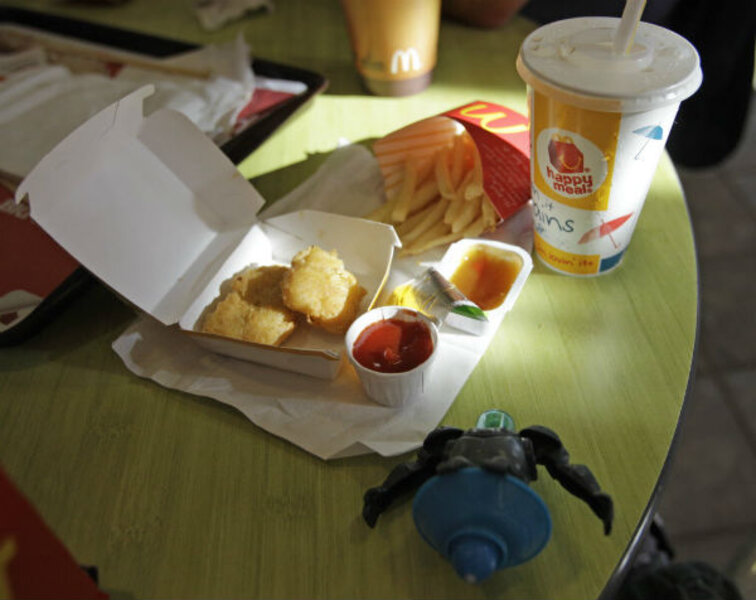Chicken nuggets: You won't believe what's in them, again
Loading...
If you want a really scary kid favorite for the Halloween table forget making Jell-O worms and pick up some fast food chicken nuggets; according to a study by Mississippi researchers, some brands contain enough creepy-crawly chicken parts to send chills up the parental spine.
For the record, we knew about this back in 2010 when parents first saw the viral photos of extruded pink goop known as MSP (mechanically separated poultry) which according to the USDA is made by mechanically separating eyes, organs, cartilage, and other scraps from carcasses and processing the sludge with salt and flavor additives into chicken nuggets kids love.
Yet researchers in Mississippi are still able to shock the world with the news that samples taken from two fast food chains in Jackson were 40-50 percent muscle, and the remainder was fat, cartilage, and pieces of bone. McDonald's switched to all white meat back in 2003.
So technically it is “chicken” just not any of the parts we would ever choose to serve to our children.
"What has happened is that some companies have chosen to use an artificial mixture of chicken parts rather than low-fat chicken white meat, batter it up and fry it, and still call it chicken," lead author Dr. Richard D. deShazo of the University of Mississippi Medical Center in Jackson, told Reuters Health.
The truth hurts even more as deShazo points out the obvious, "It is really a chicken by-product high in calories, salt, sugar, and fat that is a very unhealthy choice. Even worse, it tastes great and kids love it and it is marketed to them."
I will never forget watching chef Jamie Oliver do his famous chicken nugget experiment which “never fails” on kids in the U.K., as it completely tanked when tried on American children back in 2012.
Mr. Oliver painstakingly demonstrated for a group of elementary school kids how fast food nuggets are made. He chopped up a raw chicken, removed all the “good meat” we normally use and held up the carcass. The kids all squealed in disgust.
It was looking good for Oliver as he put the carcass into the food processor and then strained the pink goop through a sieve.
He mixed in chemicals and flavor boosters while explaining how gross and unhealthy it all was as he flattened the new “dough.”
Here’s where he lost them.
He took out a cookie cutter and popped out two “nuggets” which he dusted with bread crumbs and fried in oil.
While we have yet to invent smellavision, I could see it coming as soon as the kids inhaled the scent of salty, fatty, connective tissue and breadcrumbs frying.
Sadly, Oliver was blind-sided as he triumphantly pointed to the abomination that was turning a golden brown and said, “Now, who would still eat this?”
Without the slightest hesitation every hand shot into the air.
Oliver is so badly shocked that he keeps trying to get the kids to see the error asking, “Is that good food or bad food for you?”
Kids: “Bad”
Oliver: “Why would you still eat it if you know it’s bad?”
Boy #1: “Because we’re hungry.”
Boy #2: “I’m just hungry.”
Oliver tells the camera later on that no matter how rational we try to be with kids “we have brainwashed them to like it if it’s in that friendly little shape.”
Author Anna Lappé and the Food MythBusters project premiered their second short movie earlier this month exposing what they say is “the manipulative marketing machine parents are up against in their struggle to keep their kids healthy, calls on the food industry to own up to marketing’s role in driving the epidemic of diet-related diseases.”
“Big Food spends close to $2 billion every year telling kids and teens what’s cool to eat through advertising, promotions, and sponsorships,” according to Lappe’s press release. “Meanwhile, across the country, fast-food chains are crowding out grocery stores and supermarkets, narrowing the healthy food choices available.”
Seeing all this information makes the battle seem unwinnable for parents like me who too often succumb to the affordable and battle-free nuggets and burgers.
However, I think we can fight and win against these odds because history is on our side. Look at all the seemingly impossible odds that have been overcome against other ingrained, well-financed and insidious regimes.
Are we seriously going to tell ourselves that our nation could overcome slavery, the Great Depression, and child labor in sweat shops, but we can’t beat some clown with a nugget?
Parents shall overcome marketing and we will do it one child and one healthy meal choice at a time.








